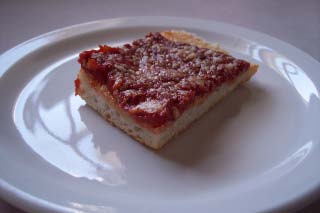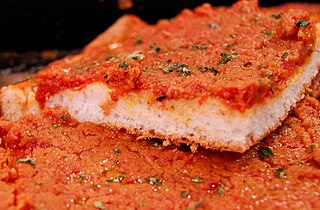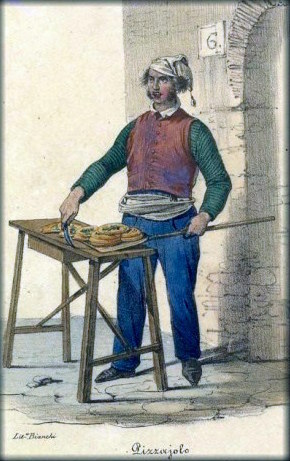
Pizza is a dish of Italian origin consisting of a usually round, flat base of leavened wheat-based dough topped with tomatoes, cheese, and often various other ingredients, which is then baked at a high temperature, traditionally in a wood-fired oven.

Focaccia is a flat leavened oven-baked Italian bread. In some contemporary places, such as Rome, it is a style of pizza, also called pizza bianca. Focaccia may be served as a side dish or as sandwich bread and it may be round, rectangular, or square shape.

A calzone is an Italian oven-baked turnover, made with leavened dough. It originated in Naples in the 18th century. A typical calzone is made from salted bread dough, baked in an oven and stuffed with salami, ham or vegetables, mozzarella, ricotta and Parmesan or pecorino cheese, as well as an egg. Different regional variations in or on a calzone can often include other ingredients that are normally associated with pizza toppings. The term usually applies to an oven-baked turnover rather than a fried pastry, though calzoni and panzerotti are often mistaken for each other.

Italian tomato pie is an Italian-American and Italian-Canadian baked good consisting of a thick, porous, focaccia-like dough covered with tomato sauce. It may be sprinkled with Romano cheese or oregano. It is not usually served straight from the oven, but allowed to cool and then consumed at room temperature or reheated. Like Sicilian pizza, tomato pie is baked in a large rectangular pan and usually served in square slices, although in Rhode Island it is cut into rectangular strips like pizza al taglio. Tomato pie descends from and resembles the Italian sfincione, although it is not the same dish. For instance, sfincione may have toppings, is usually served hot, and has a crust more like brioche than focaccia.

New York–style pizza is a pizza made with a characteristically large hand-tossed thin crust, often sold in wide slices to go. The crust is thick and crisp only along its edge, yet soft, thin, and pliable enough beneath its toppings to be folded in half to eat. Traditional toppings are simply tomato sauce and shredded mozzarella cheese. This was a popular meal amongst poor Italians due to the ratio of product from the limited produce.

New Haven–style pizza is a style of thin-crust, coal-fired Neapolitan pizza common in and around New Haven, Connecticut. Locally known as apizza, it originated in 1925 at the Frank Pepe Pizzeria Napoletana and is now served in many other pizza restaurants in the area, most notably Sally's Apizza and Modern Apizza. This geographically limited pizza style has been favorably regarded by national critics.

Italian-American cuisine is a style of Italian cuisine adapted throughout the United States. Italian-American food has been shaped throughout history by various waves of immigrants and their descendants, called Italian Americans.

Sicilian pizza is a pizza prepared in a manner that originated in Sicily, Italy. Sicilian pizza is also known as sfincione or focaccia with toppings. This type of pizza became a popular dish in western Sicily by the mid-19th century and was the type of pizza usually consumed in Sicily until the 1860s. It eventually reached North America in a slightly altered form, with thicker crust and a rectangular shape.

Garlic fingers known also as garlic cheese fingers are an Atlantic Canadian dish, similar to a pizza in shape and size and made with the same type of dough. Instead of being cut in triangular slices, they are presented in thin strips, or "fingers".

The history of pizza begins in antiquity, as various ancient cultures produced flatbreads with several toppings.

Uruguayan cuisine is a fusion of cuisines from several European countries, especially of Mediterranean foods from Spain, Italy, Portugal and France. Other influences on the cuisine resulted from immigration from countries such as Germany and Scotland. Uruguayan gastronomy is a result of immigration, rather than local Amerindian cuisine, because of late-19th and early 20th century immigration waves of, mostly, Italians. Spanish influences are abundant: desserts like churros, flan, ensaimadas yoo (Catalan sweet bread), and alfajores were all brought from Spain. There are also all kinds of stews known as guisos or estofados, arroces, and fabada. All of the guisos and traditional pucheros (stews) are also of Spanish origin. Uruguayan preparations of fish, such as dried salt cod (bacalao), calamari, and octopus, originate from the Basque and Galician regions, and also Portugal. Due to its strong Italian tradition, all of the famous Italian pasta dishes are present in Uruguay including ravioli, lasagne, tortellini, fettuccine, and the traditional gnocchi. Although the pasta can be served with many sauces, there is one special sauce that was created by Uruguayans. Caruso sauce is a pasta sauce made from double cream, meat, onions, ham and mushrooms. It is very popular with sorrentinos and agnolotti. Additionally, there is Germanic influence in Uruguayan cuisine as well, particularly in sweet dishes. The pastries known as bizcochos are Germanic in origin: croissants, known as medialunas, are the most popular of these, and can be found in two varieties: butter- and lard-based. Also German in origin are the Berlinese known as bolas de fraile, and the rolls called piononos. The facturas were re-christened with local names given the difficult German phonology, and usually Uruguayanized by the addition of a dulce de leche filling. Even dishes like chucrut (sauerkraut) have also made it into mainstream Uruguayan dishes.

Pizza arrived in the United States in the early 20th century along with waves of Italian immigrants who settled primarily in the large cities of the Northeast. It got a boost both in popularity and regional spread after soldiers stationed in Italy returned from World War II.

Regional street food is street food that has commonalities within a region or culture.

Trenton tomato pie or New Jersey tomato pie is a type of circular, thin-crust Italian tomato pie created in Trenton, New Jersey, United States, around the early 20th century in which cheese and other toppings are added on first, then the sauce.

Pizza by the slice is pizza sold in slices as a fast food by a restaurant or street vendor. Some restaurants and pizza stands only sell pizza by the slice, while others sell both slices and whole pizzas. The jumbo slice is a large-sized slice of New York–style pizza made in areas of Washington, D.C. Pizza al taglio is a style of rectangular slice of pizza that originated in Rome and is typically sold by weight.

Roman pizza is a style of pizza originating in Rome, but now widespread, especially in central Italy.



















